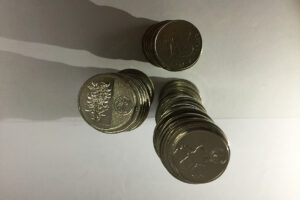




Philippines Trade Update: Trade trajectories trend along
 DOWNLOAD
DOWNLOAD

Policy Rate Updates: Double cut finale
 DOWNLOAD
DOWNLOAD

Monthly Economic Update: One for the road
 DOWNLOAD
DOWNLOAD


Peso sinks to near 9-month low as US dollar maintains strength

The peso depreciated to a near nine-month low on Wednesday as the dollar gained ground amid rising US bond yields and global oil prices.
The local currency closed at PHP 56.94 versus the dollar on Wednesday, declining by 14 centavos from Tuesday’s PHP 56.80 finish, data from the Bankers Association of the Philippines’ website showed.
This was the peso’s worst finish since it closed at PHP 57.375 per dollar on November 22, 2022.
The local unit opened Wednesday’s session weaker from Tuesday’s close at PHP 56.90 per dollar. Its intraday best was at PHP 56.80, while its worst showing was at PHP 56.99 against the greenback.
Dollars traded went down to USD 1.36 billion on Wednesday from the USD 1.52 billion on Tuesday.
The peso declined amid broad dollar strength after US bond yields and oil prices rose on Wednesday, ING Bank N.V. Manila Senior Economist Nicholas Antonio T. Mapa said in a Viber message.
“The peso weakened as global crude oil prices continued to rally after Saudi Arabia and Russia maintained supply restrictions,” a trader said in an e-mail.
The dollar held close to a six-month peak as jitters over China and global growth weighed on risk appetite, while the yen strengthened as Japan’s top currency diplomat sent a warning about the currency after it earlier dropped to a 10-month low, Reuters reported.
The yen strengthened by as much as 0.4% to 147.02 per US dollar after Japan’s top currency diplomat, Masato Kanda, said they won’t rule out options if speculative moves persist, the strongest warning since mid-August.
By 0813 GMT, it stood at 147.47 per dollar, compared with 147.82 earlier in the session, which was its lowest since Nov. 4.
The Asian currency has hovered around the key 145-per-dollar level for the past few weeks, leading traders to keep a wary eye on signs of intervention by Tokyo.
Against a basket of currencies, the dollar was at 104.77, not far off the six-month high of 104.90 touched on Tuesday. Economic data from China and Europe on Tuesday fanned some fears of slowing global growth, pushing investors to scramble for the greenback.
The yield on the benchmark US 10-year Treasury note rose nine basis points to 4.26% after reaching 4.268%, its highest since Aug. 25.
Meanwhile, oil prices surged more than 1% in the previous session, as markets worried about a supply shortage after Saudi Arabia and Russia extended their voluntary supply cuts to the end of the year.
“This development could mean inflation stays higher for longer which could mean central banks have less room to maneuver,” Mr. Mapa said.
For Thursday, the peso could trade depending on the dollar’s movement, he said.
Meanwhile, the trader said the peso could strengthen as the dollar might weaken on potentially strong European gross domestic product data.
The trader sees the peso moving between P56.80 and P57 per dollar on Thursday. — AMCS with Reuters
This article originally appeared on bworldonline.com





 By BusinessWorld
By BusinessWorld